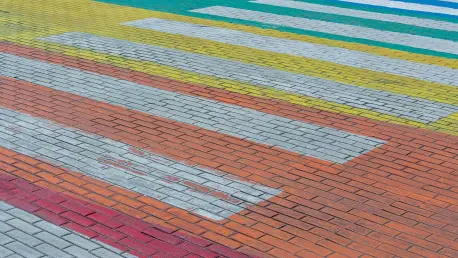In a striking display of tension between local values and state mandates, a vibrant rainbow crosswalk in Miami Beach, Florida, once a celebrated symbol of diversity and inclusion, has been removed under directives from the Florida Department of Transportation (FDOT). This crosswalk, located at the intersection of Ocean Drive and 12th Street near the iconic Twist gay bar, stood as a tribute to the city’s commitment to equality and the legacy of architect Leonard Horowitz, whose rainbow pastel palette shaped the Art Deco aesthetic of the area. Its removal has sparked outrage among local leaders and residents who saw it as more than just paint on asphalt—it was a beacon of pride and a reflection of the community’s identity. The decision, rooted in state policies prioritizing uniform traffic standards over cultural expressions, has ignited a broader debate about the balance between safety regulations and the preservation of meaningful public spaces across Florida.
Local Outcry and Cultural Loss
The decision to dismantle the Miami Beach rainbow crosswalk has drawn sharp criticism from city officials who argue that it was not only a safe pedestrian feature but also a powerful emblem of inclusivity. Commissioner Alex Fernandez has been vocal in his opposition, highlighting that the crosswalk was among the safest on Ocean Drive, with no evidence of it posing a risk to pedestrians or drivers. The removal, executed on October 5, was seen as an unnecessary expense of taxpayer funds, especially when the funds could have been allocated to other pressing needs. Fernandez emphasized that such actions from state authorities in Tallahassee cannot erase the core identity of Miami Beach, which remains steadfast in its commitment to diversity. This sentiment resonates deeply with residents who frequented the area, often taking pride in the visibility of a landmark that honored the LGBTQ+ community and reinforced the city’s welcoming atmosphere in a tangible way.
Beyond the immediate loss of the crosswalk, the incident has stirred a profound sense of frustration over the perceived erosion of local autonomy. The rainbow design, installed several years ago, had become a point of connection for both locals and tourists, symbolizing a shared value of acceptance in a city known for its vibrant cultural tapestry. Its removal is not just the loss of a physical marker but a blow to the spirit of a community that has long championed progressive ideals. Local leaders worry that such state-driven decisions undermine the unique character of individual cities, reducing public spaces to mere functional zones devoid of personality or meaning. The debate extends beyond aesthetics, touching on questions of how much control state policies should exert over municipal expressions of identity, especially when those expressions are widely supported by the people who live there.
Statewide Policy and Broader Impact
Across Florida, the removal of the Miami Beach crosswalk is part of a larger trend where state transportation officials are enforcing strict compliance with traffic control standards, often at the expense of local cultural landmarks. Similar Pride-themed street art, such as a rainbow intersection in Delray Beach, has also been painted over, despite legal efforts by local officials to preserve it. The FDOT cites safety and standardization as the primary reasons for these actions, asserting that non-compliant street designs could potentially confuse drivers or pedestrians. However, critics argue that there is little concrete evidence to support claims of safety risks associated with these colorful crosswalks. Instead, many see the removals as a prioritization of uniformity over the diverse identities of Florida’s cities, raising concerns about the suppression of community values under the guise of regulation.
This pattern of state intervention has sparked a wave of resistance among affected municipalities, with local leaders and residents feeling that their voices are being sidelined. In response to the loss of physical symbols like crosswalks, some cities are exploring creative alternatives to maintain their commitment to inclusivity. Options such as installing plaques, banners, or murals, renaming streets, and even projecting rainbow-colored lights onto public structures are being considered as ways to honor the LGBTQ+ community without violating state traffic guidelines. These efforts reflect a determination to adapt rather than surrender to state mandates, showcasing resilience in the face of policy constraints. The broader impact of these removals extends to how public spaces are defined—whether as mere functional areas or as canvases for cultural expression—and underscores an ongoing clash between state authority and local heritage.
Navigating Future Expressions of Identity
Reflecting on the removal of the rainbow crosswalk in Miami Beach, the event marked a significant moment of contention between state regulations and municipal values. The action, driven by the FDOT’s push for standardization, left a void in a community that cherished the symbol as a representation of pride and unity. Local leaders like Commissioner Fernandez stood firm against the decision, decrying the waste of public funds and the disregard for a safe, meaningful landmark. Meanwhile, other Florida cities faced similar challenges, with their own expressions of diversity being erased under the same state policies. The collective response from these communities highlighted a shared frustration over the loss of autonomy in shaping their public spaces.
Looking ahead, the focus shifts to innovative solutions that can sustain cultural identities within the constraints of state rules. Cities are encouraged to explore alternative methods—whether through murals, light projections, or street renamings—to keep the spirit of inclusivity alive. Collaboration between local governments and state authorities could also pave the way for policies that respect both safety standards and community values. As Florida navigates this divide, the resilience shown by affected areas offers hope for a future where public spaces can reflect diverse identities without conflict. Engaging in dialogue and advocating for flexible regulations may ensure that symbols of pride find new forms of expression, preserving the essence of what makes each city unique.









